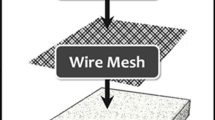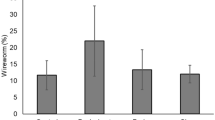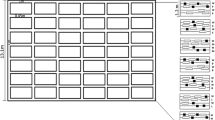Abstract
Wireworms, the larval stage of click beetles (Coleoptera: Elateridae), continue to be one of the major concerns of cereal producers, primarily due to the lack of effective pesticides and species-specific management options. To have a better understanding of species-specific interactions of one of the most damaging wireworms in the Pacific Northwest and intermountain regions of the USA, a greenhouse study was set to evaluate the damage from the sugar beet wireworm Limonius californicus to wheat and barley planted at different depths and in soil media with varying levels of organic content and texture. Overall, the evaluated wheat appeared to be more susceptible than the barley, showing greater reductions in emergence success and foliar biomass. The greatest loss of foliar biomass was observed in peatmoss-dominated medium, as indicated by a significant host plant-by-soil media interaction. Percentage of plants fed upon by L. californicus was significantly higher in the sand-dominated medium than peatmoss-dominated and 1:1 mix media. Moreover, manipulation of soil media by the addition of diatomaceous earth showed no consistent effect in protecting the planted wheat. Our findings indicated that in addition to quantifying wireworm species-specific interactions, host plant interactions with the environment in the presence of wireworm infestation should also be further studied. These relationships could influence the outcome of integrated management approaches and future risk assessment models and recovery plans.







Similar content being viewed by others
References
Arthur FH, Throne JE (2003) Efficacy of diatomaceous earth to control internal infestations of rice weevil and maize weevil (Coleoptera: Curculionidae). J Econ Entomol 96:510–518
Barsics F, Haubruge E, Verheggen FJ (2013) Wireworms’ management: an overview of the existing methods, with particular regards to Agriotes spp. (Coleoptera: Elateridae). Insects 4:117–152
Chen J, Wheeler J, Clayton J, Zhao W, O’Brien K, Zhang J, Jackson C, Marshall JM, Brown BD, Campbell K, Chen XM, Zemetra R, Souza EJ (2013) Registration of ‘UI Stone’ soft white spring wheat. J Plant Regist 7:321–326
Chen J, Wheeler J, O’Brien K, Zhao W, Klassen N, Zhang J, Bowman B, Wang Y, Jackson C, Marshall JM, Chen XM (2016) Release of ‘UI Platinum’ hard white spring wheat. J Plant Regist 10:36–40
Cherry R, Stansly P (2008) Abundance and spatial distribution of wireworms (Coleoptera: Elateridae) in Florida sugarcane fields on muck versus sandy soils. Fla Entomol 91:383–387
Collins DA (2006) A review of alternatives to organophosphorus compounds for the control of storage mites. J Stored Prod Res 42:395–426
Cook RJ, Veseth RJ (1991) Wheat health management. American Phytopathological Society Plant Health Management Series. APS Press, St. Paul
Ebeling W (1971) Sorptive dusts for pest control. Annu Rev Entomol 16:123–158
Ebeling W, Wagner RE (1959) Rapid desiccation of drywood termites with insert sorptive dusts and other substances. J Econ Entomol 52:190–207
Esser AD, Milosavljevic I, Crowder DW (2015) Effects of neonicotinoids and crop rotation for managing wireworms in wheat crops. J Econ Entomol 108:1786–1794
Faulde MK, Tisch M, Scharninghausen JJ (2006) Efficacy of modified diatomaceous earth on different cockroach species (Othoptera, Blattellidae) and silverfish (Thysanura, Lepismatidae). J Pest Sci 79:155–161
Gfeller A, Laloux M, Barsics F, Kati DE, Haubruge E, du Jardin P, Verheggen FJ, Lognay G, Wathelet JP, Fauconnier ML (2013) Characterization of volatile organic compounds emitted by barley (Hordeum vulgare L.) roots and their attractiveness to wireworms. J Chem Ecol 39:1129–1139
Hawkins JH (1936) Relation of soil utilization to wireworm injury. J Econ Entomol 29:728–731
Hermann A, Brunner N, Hann P, Wrbka T, Kromp B (2013) Correlations between wireworm damages in potato fields and landscape structure at different scales. J Pest Sci 86:41–51
Higginbotham RW, Froese PS, Carter AH (2014) Tolerance of wheat (Poales: Poaceae) seedlings to wireworm (Coleoptera: Elateridae). J Econ Entomol 107:833–837
Jones EW (1951) Laboratory studies on the moisture relations of Limonius (Coleoptera: Elateridae). Ecology 32:284–293
Jones EW, Shirck FH (1942) The seasonal vertical distribution of wireworms in the soil in relation to their control in the Pacific Northwest. J Agric Res 56:125–142
Kephart KD, Stark JC, and Robertson L (1989) Irrigated spring wheat production guide for Southern Idaho. University of Idaho College of Agricultural and Life Sciences Extension Bulletin 697
Korunic Z (1998) Diatomaceous earth, a group of natural insecticides. J Stored Prod Res 34:87–97
Lafrance J (1968) The seasonal movements of wireworms (Coleoptera: Elateridae) in relation to soil moisture and temperature in organic soils of Southwestern Quebec. Can Entomol 100:801–807
Lange WH, Carlson EC, Leach LD (1949) Seed treatments for wireworm control with particular reference to the use of lindane. J Econ Entomol 42:942–955
Lefko SA, Pedigo LP, Batchelor WD, Rice ME (1998) Spatial modeling of preferred wireworm (Coleoptera: Elateridae) habitat. Environ Entomol 27:184–190
Mewis I, Ulrichs Ch (2001) Action of amorphous diatomaceous earth against different stages of the stored product pests Tribolium confusum, Tenebrio molitor, Sitophilus granarius and Plodia interpunctella. J Stored Prod Res 37:153–164
Milosavljevic I, Esser AD, Crowder DW (2015) Identifying wireworms in cereal crops. Washington State University Extension FS175E
Mohan S, Fields PG (2002) A simple technique to assess compounds that are repellent or attractive to stored-product insects. J Stored Prod Res 38:23–31
Morales-Rodriguez A, O’Neill RP, Wanner KW (2014) A survey of wireworm (Coleoptera: Elateridae) species infesting cereal crops in Montana. Pan Pac Entomol 90:116–125
Parker WE, Seeney FM (1997) An investigation into the use of multiple site characteristics to predict the presence and infestation level of wireworms (Agriotes spp., Coleoptera: Elateridae) in individual grass fields. Ann Appl Biol 130:409–425
Rashed A, Etzler F, Rogers CW, Marshall JM (2015) Wireworms in Idaho cereals: Monitoring and identification. University of Idaho Extension Bulletin 898
Reddy GV, Tangtrakulwanich K, Wu S, Miller JH, Ophus VL, Prewett J, Jaronski ST (2014) Evaluation of the effectiveness of the entomopathogens for the management of wireworms (Coleoptera: Elateridae) on spring wheat. J Invertebr Pathol 120:43–49
Robertson LD, Guy SO, Brown BD (2004) Southern Idaho dryland winter wheat production guide. University of Idaho. College of Agricultural and Life Sciences Extension Bulletin 827
Traugott M, Pazmandi C, Kaufmann R, Juen A (2007) Evaluating 15 N/14 N and 13C/12C isotope ratio analysis to investigate trophic relationships of elaterid larvae (Coleoptera: Elateridae). Soil Biol Biochem 39:1023–1030
Traugott M, Schallhart N, Kaufmann R, Juen A (2008) The feeding ecology of elaterid larvae in central European arable land: new perspectives based on naturally occurring stable isotopes. Soil Biol Biochem 40:342–349
Traugott M, Benefer CM, Blackshaw RP, van Herk WG, Vernon RS (2015a) Biology, ecology, and control of elaterid beetles in agricultural land. Annu Rev Entomol 60:313–334
Traugott M, Schallhart N, Staudacher K, Wallinger C (2015b) Understanding the ecology of wireworms and improving their control: a special issue. J Pest Sci 86:1–2
Van Herk WG, Vernon RS (2006) Effect of temperature and soil on the control of a wireworm, Agriotes obscurus L. (Coleoptera: Elateridae) by flooding. Crop Prot 25:1057–1061
Vernon RS, van Herk WG, Tolman J, Ortiz Saavedra H, Clodius M, Gage B (2008) Transitional sublethal and lethal effects of insecticides after dermal exposures to five economic species of wireworms (Coleoptera: Elateridae). J Econ Entomol 101:365–374
Vernon RS, van Herk WG, Clodius M, Harding C (2009) Wireworm management I: stand protection versus wireworm mortality with wheat seed treatments. J Econ Entomol 102:2126–2136
Acknowledgments
We would like to thank our field technician Fabiola Aguilar, our laboratory technician Scott Pristupa, and our laboratory assistant Cindrie Lowder for their help with different aspects of this experiment. Funding for this project was provided by the Idaho Wheat Commission, Idaho Barley Commission, USDA-ARS-REACCH-2011-68002-30191 and USDA-NIFA-Hatch-IDA01506.
Author information
Authors and Affiliations
Corresponding author
Additional information
Handling Editor: Joseph Dickens.
Rights and permissions
About this article
Cite this article
Rashed, A., Rogers, C.W., Rashidi, M. et al. Sugar beet wireworm Limonius californicus damage to wheat and barley: evaluations of plant damage with respect to soil media, seeding depth, and diatomaceous earth application. Arthropod-Plant Interactions 11, 147–154 (2017). https://doi.org/10.1007/s11829-016-9474-4
Received:
Accepted:
Published:
Issue Date:
DOI: https://doi.org/10.1007/s11829-016-9474-4




